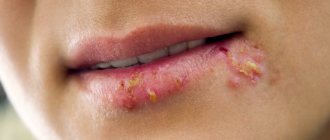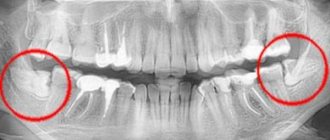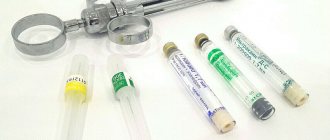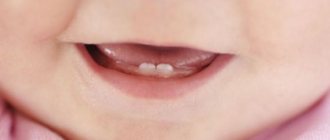If you are concerned about inflammation of the gums in the area of the mouth where the wisdom tooth is located, it is likely that you are developing pericoronitis
. The essence of this disease is that the gums that surround the tooth become inflamed. This situation usually occurs when eruption is difficult or incomplete. In practice, this disease most often occurs when the lower wisdom teeth erupt.
The pain may increase with chewing, pressing on the tooth, swallowing, or contact with hot, sour or cold foods. A feeling of discomfort may occur when opening the mouth.
Visually pericoronitis
characterized by reddened and swollen gums located near the erupting tooth, while pus may be released from the gums, and the patient’s temperature may rise to 38 degrees.
Quite often, the eruption of wisdom teeth is accompanied by complications in people, the cause of which may be insufficient space for its growth or incorrect position of the tooth in the jaw.
If a wisdom tooth does not fully erupt, a kind of hood forms over it, which is a gum that partially covers the tooth. A certain space appears between the tooth and the gum, where there are favorable conditions for the accumulation of microorganisms and food debris, which ultimately leads to the development of caries or other serious diseases.
Pericoranitis is treated surgically in a dental clinic. The gum that hangs over the wisdom tooth is incised, and the resulting wound is treated with a strong antiseptic solution. If the dentist believes that such dental treatment will not bring relief to the patient, then a decision is made to remove the wisdom tooth.
Read also
The gum under the tooth hurts
Gum inflammation
Inflamed and bleeding gums
If the pain suddenly overtakes a person, and he does not have the opportunity to visit the dentist at the moment, you can reduce the pain by following these recommendations:
- To avoid aggravating gum inflammation, do not apply warm compresses to it;
- to relieve the pain caused by a wisdom tooth, take 1-2 tablets of analgin, paracetamol or tempalgin;
- It is recommended to rinse your mouth with a weak solution of soda at room temperature;
- do not take anti-inflammatory drugs and antibiotics without a doctor’s recommendation;
- At the first symptoms of pericoronoritis, contact your dentist immediately.
It should be noted that all of the above methods only temporarily reduce gum inflammation caused by an erupting wisdom tooth, and in order to completely eliminate the causes of pain, the help of a professional dentist is necessary.
Fighting gum swelling using traditional medicine
In addition to medications, traditional medicine also helps reduce signs of swelling.
Recommended use:
- aloe. You can use either a freshly picked leaf or aloe juice purchased at a pharmacy. A sheet or cotton swab moistened with juice is applied to the gum, which leads to relief of the inflammatory process;
- infusion of St. John's wort - used for rinsing. The product has a short shelf life - after opening, the medicine can be stored in the refrigerator for no more than a day;
- Propolis is a substance with bactericidal properties. Available in pharmacies and also from beekeepers. Propolis is used both for rinsing and simply for chewing. Since propolis is made from honey, before using it you should make sure that you are not allergic to this product;
- honey with salt - used to relieve severe swelling of the gums. The product is rubbed into the damaged area with gentle massaging movements;
- lemon balm decoction. It is advisable to rinse if there is redness of the gums and itching;
- decoction of calendula and chamomile. You can use either individually or a mixture of herbs. They are filled with water and brought to a boil. This is an affordable remedy that has good anti-inflammatory and antiseptic effects;
- a solution based on soda and salt. Add a teaspoon of salt and soda to 200 milliliters of hot water. Rinsing helps temporarily relieve pain and reduce inflammation;
- Oak bark is another natural component ideal for rinsing. It has astringent properties, which helps reduce bleeding gums. It’s easy to prepare the solution - pour 2 tablespoons of powder into a glass of boiling water, after which the product is allowed to brew for half an hour.
Eruption of wisdom teeth: inflammation and consequences
The figure eight on the lower jaw begins to create problems from the moment of eruption, when the crown rests closely on the adjacent tooth or is tightly covered with a hood. When the hood becomes inflamed, favorable conditions are created under it for the proliferation of pathological microorganisms, and the gums are involved in the process. This manifests itself as pain during chewing or when accidentally biting the mucous membrane. It happens that a wisdom tooth partially erupts, and one or more tubercles rest against the hood, injuring it. In this case, the inflammation of the gums near the wisdom tooth will have to be treated by removing the hood or the tooth itself. If the figure eight is healthy and does not interfere with the adjacent tooth during eruption, then the dentist makes an incision in the hood so that the tooth can erupt calmly.
How to treat inflammation of the hood and gums near the wisdom tooth at home? To do this, you will need to regularly rinse, rinse the mouth with antiseptic solutions and take analgesic and anti-inflammatory drugs for pain relief: Nimesil, Ketanov, Ibuprofen. If the hood is inflamed, you can rinse your mouth with weak solutions of the antiseptic Chlorhexidine, soda and saline solutions.
When swelling is normal
Swelling after wisdom tooth removal is a consequence of:
- allergies to medications used during surgery or to sutures applied after wisdom tooth removal;
- purulent inflammatory focus, usually eliminated before surgery;
- severe traumatic damage due to difficult removal;
- infection of soft tissues during the procedure;
- non-compliance with doctor's instructions.
A swollen cheek after wisdom tooth removal can be caused by chronic diseases: hypertension, neuralgia, psycho-emotional disorders. Along with the cheek, the gums may also swell after wisdom tooth removal.
How long after wisdom tooth removal the swelling disappears depends on the nature and complexity of the operation. As a rule, it gradually goes away within 3-7 days. The pain after wisdom tooth removal is aching in nature and occurs due to a violation of the integrity of tissues, blood vessels, and nerves.
Negative sensations in the jaw after wisdom tooth removal often appear due to prolonged sitting motionless with an open mouth during surgery. If your gums hurt after wisdom tooth removal, it is recommended to take analgesics.
Blood after wisdom tooth removal is the result of damaged blood vessels. Within a few hours after surgery, the bleeding should stop. The temperature after wisdom tooth removal may rise to 37.5°C, but after a few days it should return to normal.
How much it hurts after wisdom tooth removal depends on the complexity of the surgical procedure. Typically, the healing period does not exceed a week.
Pericoronitis: how to treat gum inflammation at home?
Pericoronitis is accompanied by very unpleasant sensations. This disease occurs just during the eruption of a wisdom tooth, and you need to know how to relieve inflammation of the figure eight, especially in the lower jaw.
Surgical removal of the hood is only half of the treatment; the crown continues to erupt, so you need to prevent inflammation at home. It is important to give the figure eight space to erupt in a timely manner in order to eliminate infection and all its consequences. If your figure eight is erupting and this is accompanied by unpleasant symptoms, it is better not to delay and contact Leaderst dentists. At a free consultation, you will receive information that will protect you from teething problems, help you avoid tooth extraction and maintain oral health.
What to do and how to treat the gums when the figure eight erupts on the upper and lower jaws?
- Clean the oral cavity thoroughly, despite slight discomfort, since the largest number of microorganisms accumulate in the area of the erupting figure eight, which can cause pericoronitis;
- Use additional hygiene products: irrigator, rinses are very important for the prevention of gum disease not only during the teething of the figure eight, but throughout life;
- The eruption itself, even without inflammation, causes discomfort, and to relieve pain in the area of the third molar, you can take drugs such as Nimesil, Ketanov, Nise, Ibuprofen, they not only relieve pain, but also fight inflammation in the tooth area;
- Under no circumstances should you apply hot compresses to your cheek, and especially to your tooth; only cold compresses can relieve pain for a while;
- It is necessary to treat the hood not only locally, but also by following general principles, that is, eat right, avoid hypothermia, since a decrease in the protective mechanism provokes an intensification of the clinical picture, and then it will be more difficult to remove the infection and relieve pain;
- You also need to treat inflammation with folk remedies: rinse your mouth with a decoction of chamomile, sage, oak bark, and take baths.
How long does a tooth hurt when there is a complication?
If the wisdom tooth does not grow in the required 60 days, something did not go according to plan. And in such cases, when talking about timing, dentists do not undertake to give any forecasts. Perhaps, with careful adherence to oral hygiene and constant monitoring by a doctor, the third molar will still grow in the near future.
But there is no less chance that the process will become chronic. Millions of people around the world experience excruciating exacerbations for years. The pain subsides for a while, but after a couple of months, and sometimes a couple of years, the tooth begins to cut again, and the pain returns with renewed vigor.
High fever and pain due to inflammation of the hood
The eruption of the figure eight may be accompanied by general symptoms such as high fever, weakness, nausea, and lack of appetite. Such signs are associated with infection, so you need to consult a doctor, since treating intoxication at home is unsafe. First aid will be to drink plenty of fluids and take diuretics. A high temperature during the eruption of the figure eight can last for several days, so the doctor will individually prescribe antipyretics and tell you how to relieve pain and treat inflammation in the gum area in order to avoid unpleasant symptoms in the future. It is easy to remove inflammation and relieve pain at home, but this will only mask a serious disruption in the process of teething, so it is important to know the dangerous symptoms that require immediate consultation with a dentist.
When should you see a dentist if your figure eight is teething and your hood is inflamed?
- It is not possible to treat inflammation at home, and the symptoms only get worse;
- The gums near the figure eight are swollen, there is throbbing pain;
- It hurts to chew and swallow, the symptoms make it difficult to sleep at night;
- It is not possible to relieve pain in the gum area with analgesics;
- The gums around the figure eight swell, purulent exudate accumulates;
- The figure eight erupts incorrectly and puts pressure on the adjacent tooth.
What such phenomena can lead to without treatment, you will be told at the Leaderstom clinic, where consultation is not only free, but also saves the health of the eight and the entire dentition.
Causes of inflammation
Inflammation of the gums near the eighth tooth is accompanied by pain and discomfort. To diagnose the disease, it is necessary to take an X-ray of the tooth and take a blood test. Based on the results of the studies, the doctor makes a decision:
- Remove the tooth.
- Prescribe therapeutic treatment.
- Or cut the gum.
The gums can become inflamed and painful, most often due to the incorrect position of the tooth, which has difficulty erupting and grows in the wrong direction relative to the dental arch. The number eight can take a very long time to erupt, up to several years.
In what cases is it better to remove a tooth?
Old school dentists insist that at the first discomfort of the patient, wisdom teeth should be removed without regret. Modern dentistry is more humane and is convinced of the need for strict indications for the procedure, rightly noting that in due time “eights” may become the only possible support for dentures.
Indications for removal are:
- eruption of the third molar outside the dentition;
- threat of displacement of adjacent teeth;
- abnormal position of the crown and pressure on the second molar;
- impossibility of therapeutic treatment of the tooth.
Today, at the first visit with complaints of pain caused by the “eight”, the dentist first takes an x-ray to examine the position of the roots, the shape of the tooth and its condition. And only then evaluates all the risks. With this approach, a wait-and-see tactic is increasingly being chosen: the doctor selects painkillers that will help survive the pain that is natural to the teething process. If necessary, incises the gum and cuts off the hood. And then for several months he observes how the wisdom tooth will behave.
Dentists of the Israeli school even fight for impacted wisdom teeth, pulling them out and putting them in the right place with the help of orthodontic instruments. The main thing is that there is enough space in the patient's jaw.
Is it painful to have a wisdom tooth removed?
26% of operations to remove “eights” are no different from the removal of other molars. The wisdom tooth is simply pulled out using hand forceps after local anesthesia is administered. In this case, the patient, as a rule, does not even have time to get scared, the whole procedure goes so quickly.
Another thing is difficult removal. This operation can last up to 40 minutes, during which the surgeon saws the tooth with a drill and takes it out in parts. Unfortunately, this is the only way to remove a tooth that lies horizontally, or has frozen in its development, and has not erupted, but due to its location causes constant pain.
And even in this case, modern anesthesia can completely relieve pain. The same applies to the recovery period. First, in most cases, the surgeon will stitch up the resulting wound, speeding up the healing process. Secondly, he will prescribe painkillers for the coming days. Therefore, you should not be afraid of removal - it will cause much less pain than regular exacerbations.










